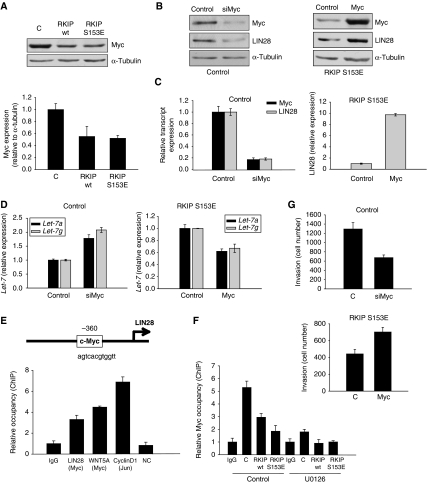Figure 4.
Myc regulates LIN28 transcription. (A) RKIP downregulates Myc expression. Blot: 1833 cells expressing control vector, wt RKIP, or S153E RKIP were lysed and immunoblotted with anti-Myc or anti-tubulin antibodies. Results are representative of at least three independent experiments. Graph: results represent the mean±s.d. for three independent samples (P=0.03 for wt RKIP and P=0.003 for S153E RKIP relative to Control). (B) Myc regulates LIN28 expression. The 1833 cells transfected with scrambled control or siRNA for Myc (left) or 1833 S153E RKIP cells transfected with a control or a Myc expression vector (right) were lysed and immunoblotted with anti-Myc, anti-LIN28, or anti-tubulin antibodies. Results are representative of at least three independent experiments. (C) Left: Myc regulates LIN28 transcript levels. The 1833 cells were transfected with a control or siRNA for Myc. LIN28 and Myc transcripts were analysed by qRT–PCR 48 h after transfection. Right: 1833 cells expressing S153E RKIP were transfected with a control or Myc expression vector. LIN28 transcripts were analysed by qRT–PCR 48 h after transfection. Results represent the mean±s.d. for three samples (P<0.0001 for siMyc and P<0.0001 for Myc relative to Control). (D) Myc regulates let-7 expression. The 1833 cells were transfected with a control or siRNA for Myc. Let-7a and g transcripts were analysed by qRT–PCR 48 h after transfection. The 1833 cells expressing S153E RKIP were transfected with a control or Myc expression vector. Let-7a and g transcripts were analysed by qRT–PCR 48 h after transfection. Results represent the mean±s.d. for three samples (P<0.01 for siMyc and P<0.01 for Myc relative to Control). (E) Myc regulates LIN28 transcription by binding to its promoter. Schematic representation of LIN28 promoter with the putative Myc-binding site. Chromatin immunoprecipitations (ChIPs) were carried out with anti-Myc antibody and anti-Jun antibody (a positive control for ChIP assay). ChIP was analysed by qRT–PCR, with primers in the LIN28, WNT5A (a positive control), CyclinD1 (a positive control for ChIP assay), and β-globin (a negative control; NC) promoters. Results represent the mean±s.d. for three samples (P<0.004 for LIN28 relative to IgG). (F) RKIP regulates Myc binding to the LIN28 promoter. Chromatin immunoprecipitation (ChIP) were carried out with anti-Myc antibody on the LIN28 promoter. The 1833 cells expressing control vector (C), wt RKIP, or S153E RKIP were treated with 2% serum or 2% serum with U0126 (10 μM) for 2 h after 48 h serum starvation. Results represent the mean±s.d. for three samples (P=0.01 and 0.001 for wt RKIP S153E RKIP, respectively, relative to untreated Control). (G) Myc expression regulates invasion of 1833 cells. Top: 1833 cells transfected with scrambled control or siRNA for Myc were assayed for invasion as described in Materials and methods. Results represent the mean±s.d. for three independent samples (P=0.004 for siMyc relative to Control). Bottom: 1833 S153E RKIP cells transfected with vector control or an expression vector for Myc were assayed for invasion as described in Materials and methods. Results represent the mean±s.d. for three independent samples (P=0.01 for Myc relative to Control).

